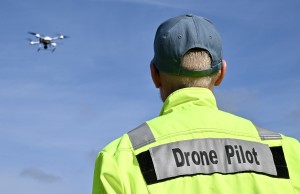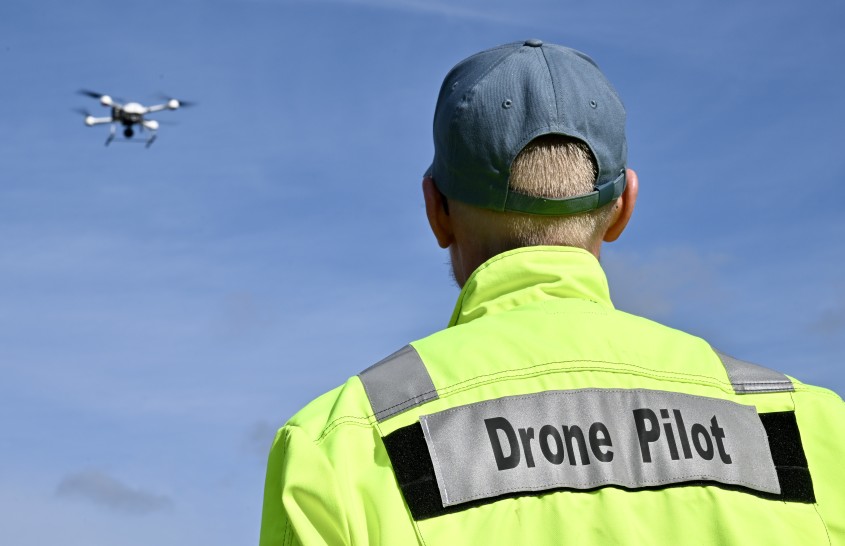Business news for the stock market
Frequentis AG: 5G drones assist emergency services during operations
Operational support from the air
Wien (pta014/24.09.2025/11:11 UTC+2)
- Vodafone, Frequentis, DLR, and the Rostock Fire Brigade are testing drones in rescue missions
- Drones transmit initial aerial images directly to the control centre – even before emergency service crews arrive
- Emergency response times are reduced by around 7 minutes
- Reliable aerial footage allows more detailed operational planning, even in hard-to-reach locations
Emergency 112: An inaccessible accident or a forest fire is spreading rapidly. For rescue teams, every second counts – but they often lack decisive information on the operation site or the situation on the ground. Especially in complex, hard-to-reach areas such as forests, crews often reach their limits in the crucial first few minutes, because many details remain unclear over the phone.
To improve this situation Vodafone, the Rostock Fire Brigade, and Frequentis have joined forces under the leadership of the German Aerospace Center (DLR) in the ADELE funding project: with 5G-controlled drones, emergency services receive high-resolution live images directly to the control centre and emergency vehicles before arriving at the scene.
"When people's lives are at stake, every second counts. We now provide emergency services with a digital tool that allows them to act faster and safer in emergency situations. Because drones share live images from the operation site even before rescue workers arrive there. This enables crews to help people in need much faster," explains Michael Reinartz, Director Innovation at Vodafone Germany.
5G drones: operational support from the air
In this project, Vodafone's 5G technology is combined with existing LifeX and ASGARD control centre software from Frequentis. If an emergency call is received that requires the deployment of a drone, the drone is automatically dispatched directly from the control centre. It flies completely automatically beyond visual line of sight (BVLOS). The DLR's special rescue drone with high-resolution camera sensors then heads directly to the scene of the emergency and transmits high-resolution live video data directly to the control centre via Vodafone's 5G real-time network – even before the first emergency vehicle leaves the control centre. This provides emergency responders with important visual information, such as fire development, access routes, potential hazardous material storage locations, and the presence of people in the affected area. This information enables a more targeted planning of the required emergency units, reducing the average response time from over nine minutes to around two minutes. A clear time gain that can save lives.
"We bring video and sensor data immediately to our LifeX or ASGARD control centre and to the approaching emergency responders. This ensures that everyone involved in the operation has the same, consistent information about the scene immediately, and at all times, regardless of location. This shared situational awareness accelerates decision-making and ensures a faster, appropriate, and effective response to the situation," says Günter Graf, Vice President New Business Development at Frequentis.
Simplification for control centre systems
Frequentis and the DLR ensure smooth implementation in practice by integrating drone control directly into existing control centre technology such as the ASGARD or LifeX communications systems. Frequentis' Automated Drone Dispatch System (ADD) is connected via a special interface. When an emergency call is received, the control centre software can transmit the location determined from the emergency call data to the ADD as geocoordinates. The ADD then suggests a possible drone deployment based on GPS data and the location of the incident.
"Our rescue drone combines high-resolution camera sensors with an optimised and low-risk flight trajectory based on current movement data. We ensure compliance with all legal regulations and full GDPR compliance to guarantee both security and data protection," says DLR project lead Andreas Volkert.
Safe drone flights and faster approvals through DroNet Hub
BVLOS flights (drone flights beyond visual line of sight) underly strict regulations, especially in inhabited areas. For approvals, ground and traffic data must assess the risk and enable safe flight routes. Vodafone has developed the "DroNet Hub" for this purpose – a platform and a complementary tool that provide current and dynamic data to make drone flights safer and approval processes more efficient. Authorities are already using this data to assess and ensure the safety of drone traffic.
More speed and security for emergency responders
"With ADELE, we bring more speed and clarity to the daily operations of police, fire departments, and other emergency services. Live images provide emergency responders with valuable information that not only gives a better overview but also saves valuable time. This allows for faster and more accurate decisions and an even faster response," says Chris von Wrycz Rekowski, Senator for Finance, Digitalisation, and Order of the Hanseatic and university city of Rostock.
The project now starts with first operations. The long-term goal is to integrate the automated drone deployment into the daily routine of authorities and organisations.
About ADELE
ADELE stands for "Automated drone deployment from the control centre" – a project funded by the Federal Ministry of the Interior through the Federal Institute for Digital Radio of Authorities and Organisations with Security Tasks (BDBOS), which tests the use of drones in the real operational environment of the Rostock professional fire department. With ADELE, the project partners bring more speed and overview to the everyday operations of the police, fire brigade and other authorities and rescue authorities.
About FREQUENTIS
Frequentis stands for a safer world. Our solutions are used in our customers' command and control centres to help them make the world safer.
Frequentis is a world leader in high-tech solutions for Air Traffic Management, supporting both civil and military air traffic control organisations, as well as Public Safety and Transport, where police, emergency rescue services, fire brigades, railways, coastguards, and port authorities rely on our extensive portfolio.
The listed family business based in Vienna, Austria, drives innovative and sustainable solutions for safety and security in everyday life and in the safety-critical sector. Its air traffic optimisation solutions for air traffic control centres are contributing to reducing emissions.
As a global player with more than 2,500 employees (full-time equivalents/FTE), Frequentis has a worldwide network of companies in over 50 countries. Its products, services, and solutions are used in around 150 countries. Shares in Frequentis are traded on the Vienna and Frankfurt stock exchanges; ISIN: ATFREQUENT09, WKN: A2PHG5. In 2024, revenues were EUR 480.3 million and EBIT was EUR 32.1 million.
For more information, please visit www.frequentis.com.
Barbara Fuerchtegott, Head of Communications/Company Spokesperson
barbara.fuerchtegott@frequentis.com, +43 1 81150-4631
Stefan Marin, Head of Investor Relations
stefan.marin@frequentis.com, +43 1 81150-1074
About Vodafone Germany
Vodafone is one of the leading telecoms companies in Germany. Vodafone's networks keep Germany connected: people and machines, families and friends as well as politics, business and society. Millions of people are Vodafone customers – whether they are surfing, making calls or watching TV, whether they are networking their office, their home or their factory with Vodafone technology.
The Düsseldorf-based company provides a comprehensive portfolio of internet, mobile, fixed and TV services. As digital transformation expert to German business and industry, Vodafone is a trusted partner to enterprises of all sizes, from startups and SMEs to DAX-listed corporations. Vodafone Germany employs about 14,000 million people and generates total revenue of around 13 billion euros with almost 30 million mobile customers, over 10 million broadband customers, approximately 9 million TV customers and numerous digital solutions. Vodafone is a key contributor to the development of Germany's infrastructure, providing gigabit speeds to more than two-thirds of the German households. Together with its partner OXG, Vodafone will build up to seven million new FTTH fibre connections in the coming years. With its 5G network, Vodafone reaches more than 93% of the population in Germany. Vodafone's NB IoT network for the industrial and business sectors is delivering IoT connectivity on almost 97% of Germany's total territory.
Vodafone Germany is the largest operating company of the Vodafone Group, one of the world's largest telecommunications companies, contributing around 33% of its revenues. Vodafone Group has over 340 million mobile and fixed customers and one of the world's largest IoT platforms.
Vodafone is creating a better future for everyone. Because technology paves the way for a more digital and sustainable tomorrow for people and businesses. The company is committed to reducing its environmental impact to reach net zero emissions by 2040.
A diversity and inclusion agenda with a wide range of measures is at the heart of the Vodafone culture. It includes support for families, networks for women, fathers and members of the LGBT+ community. Vodafone is respectful of all individuals, regardless of nationality, disability, age, religious or sexual orientation, gender identity, belief or cultural background.
More information: www.vodafone-deutschland.de or www.vodafone.com.
(end)
| Emitter: |
Frequentis AG Innovationsstraße 1 1100 Wien Austria |

|
|---|---|---|
| Contact Person: | Stefan Marin | |
| Phone: | +431811501074 | |
| E-Mail: | stefan.marin@frequentis.com | |
| Website: | www.frequentis.com | |
| ISIN(s): | ATFREQUENT09 (Share) | |
| Stock Exchange(s): | Vienna Stock Exchange (Official Trade) | |
| Other Stock Exchanges: | Regulierter Markt in Frankfurt |



